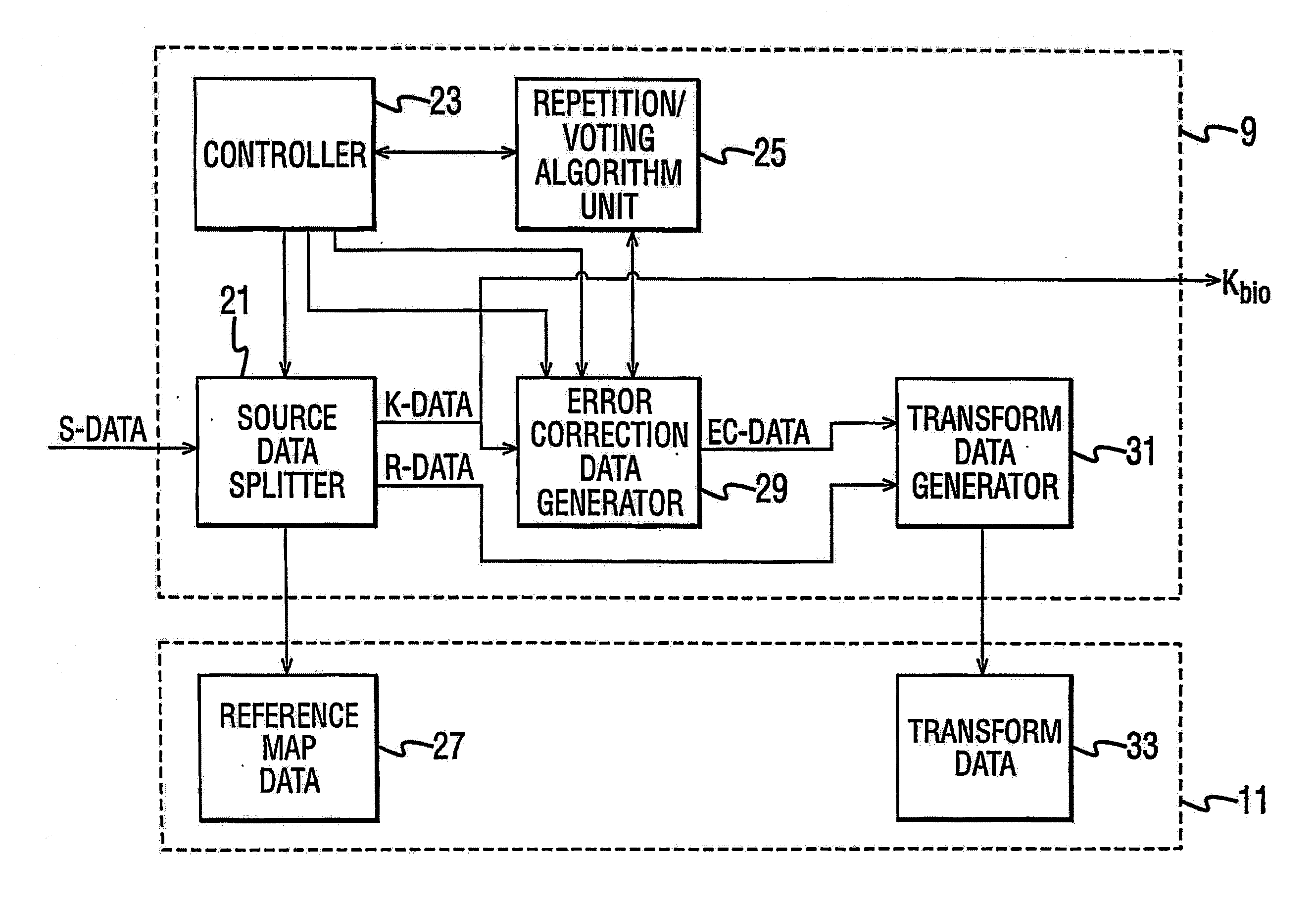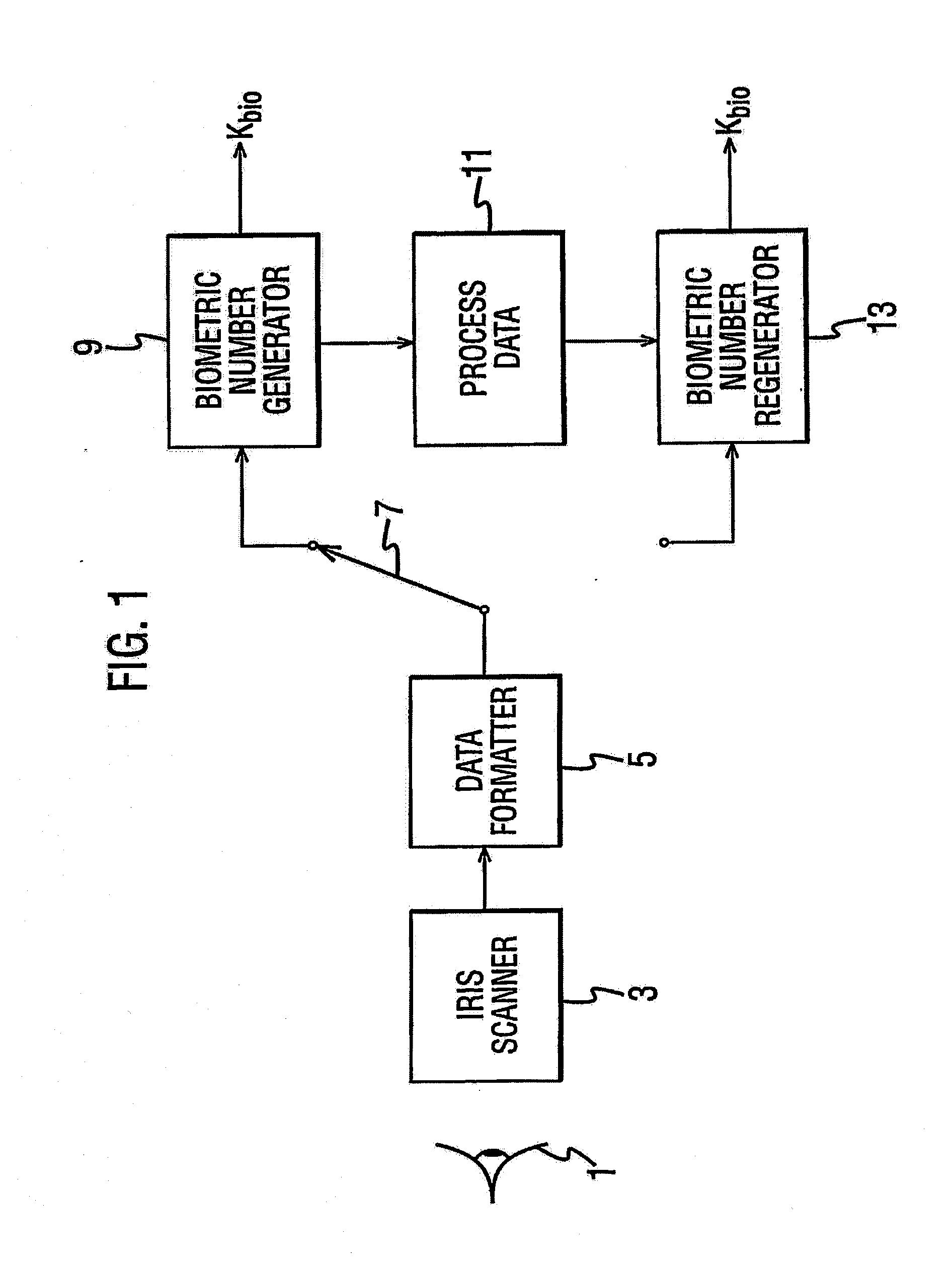Data Processing Apparatus and Method
a data processing and data technology, applied in the field of data processing apparatus and method, can solve problems such as inability to reduce the amount of error correction data required, and achieve the effect of reducing the amount of error correction data
- Summary
- Abstract
- Description
- Claims
- Application Information
AI Technical Summary
Benefits of technology
Problems solved by technology
Method used
Image
Examples
first embodiment
[0023]Overview
[0024]FIG. 1 schematically shows the main components of a system for generating a biometric number Kbio from the iris pattern of an eye 1 of a human being. As shown, an iris scanner 3 records an image of the eye 1 and outputs corresponding image data to a data formatter 5, which configures the image data into a standard format. In this embodiment, the data formatter 5 processes the image data using the image processing techniques described in U.S. Pat. No. 5,291,560, whose full content is hereby incorporated by reference, to form an iris code comprising four thousand and ninety-two bits arranged in a five hundred and twelve by eight array.
[0025]During enrolment, a switch 7 directs the iris code generated by the data formatter 5 to a biometric number generator 9, which processes the iris code to generate a biometric number Kbio and process data 11 which is stored for use in a subsequent biometric number regeneration operation. In particular, as will be described in more...
second embodiment
[0061]Overview
[0062]In the first embodiment, the iris code from the data formatter 5 is split into two parts. During enrolment, the first part is used to generate a biometric number Kbio and associated error correction data, and the second part is used to transform the error correction data to form transform data. During biometric number regeneration, the first part of the iris code is used to regenerate the biometric number, and the second part is used to revert the transform data back to error correction data. The error correction data is then used to correct errors in the regenerated biometric number.
[0063]The generated biometric number Kbio has eight hundred and eighteen bits. With this size of biometric number, there may still be a significant possibility of errors in one or more of the bits. A second embodiment will now be described, with reference to FIGS. 8 and 9, in which two passes of error correction are performed to reduce the likelihood of error in the biometric number ...
third embodiment
[0078]Overview
[0079]In the first and second embodiments, an iris code is formed by the data formatter 5 having four thousand and ninety-two data elements, with each data element comprising a single bit. An alternative type data formatter is described in International Patent Application WO 02 / 098053, the whole content of which is incorporated herein by reference. In particular, WO 02 / 098053 describes a feature template generator which extracts plural features from an image of an iris, with each feature having one or more attributes, and an attribute value stabilizer which uses data stored during enrolment to stabilize the respective values of the attributes. The resultant feature template is a forty-five by eighteen array of data elements, with each data element having a multi-bit value.
[0080]A third embodiment will now be described, with reference to FIGS. 10 to 12, in which the image data of the eye of an individual is configured by a data formatter as described in WO 02 / 098053 to ...
PUM
 Login to View More
Login to View More Abstract
Description
Claims
Application Information
 Login to View More
Login to View More - R&D
- Intellectual Property
- Life Sciences
- Materials
- Tech Scout
- Unparalleled Data Quality
- Higher Quality Content
- 60% Fewer Hallucinations
Browse by: Latest US Patents, China's latest patents, Technical Efficacy Thesaurus, Application Domain, Technology Topic, Popular Technical Reports.
© 2025 PatSnap. All rights reserved.Legal|Privacy policy|Modern Slavery Act Transparency Statement|Sitemap|About US| Contact US: help@patsnap.com



